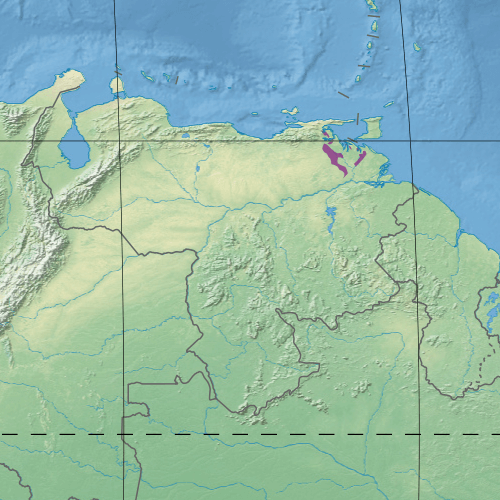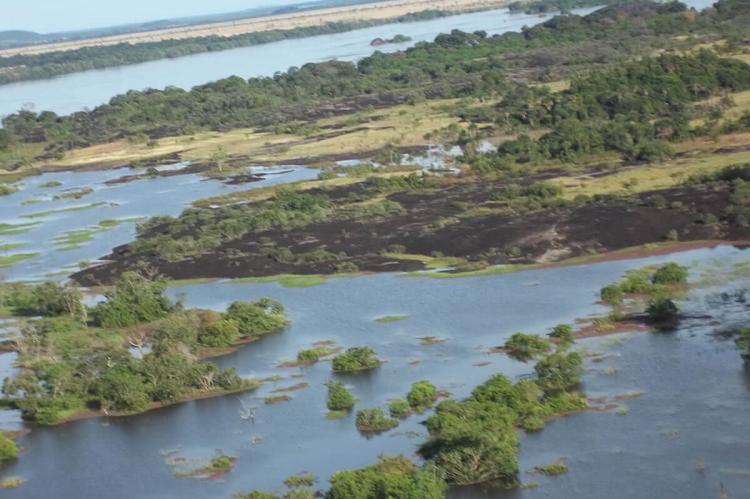Orinoco Wetlands Ecoregion (Venezuela)
The Orinoco wetlands ecoregion is located north of the Orinoco River Delta in northeastern Venezuela. It consists of several large and small patches of flooded grasslands, which occur in a habitat mosaic with swamp forests and mangroves.
Orinoco Wetlands
The Orinoco wetlands ecoregion is located north of the Orinoco River Delta in northeastern Venezuela. The delta has been formed by the sediment deposited by the Orinoco River for thousands of years.
The ecoregion consists of seven distinct large and small patches of flooded grasslands embedded in a mosaic with mangroves, swamp forests, moist forests, and llanos.
The blocks of flooded grassland occur north of the main flow of the Orinoco River, along the Boca Grande and San Juan Rivers, and within the alluvial fan of the Orinoco (Amacuro) delta.
The core portion of the Orinoco wetlands ecoregion occurs near Tucupita, along the Manamo River, which diverges from the Orinoco near Barrancas to form the western edge of the delta. The next largest patch occurs along the Macarao Canal. Others patches occur along the coast, between the mangrove and swamp forests.
Floodplains of large rivers, such as the Orinoco, are among the most productive ecosystems. Unfortunately, very little research has been conducted in the wetlands of the Orinoco Delta (Delta Amacuro). The surrounding terra firma moist forests, swamp forests and mangroves doubtlessly influence species compositions.
The terrain is flat, mostly about 1 m (3 ft 3 in) above sea level but rising to 9 m (30 ft) in levees along the coast. Soils are almost all alluvial deposits from the Andes Mountains far to the west. The delta's 360 km (220 mi) coastline moves east into the Atlantic Ocean by about 40 m (130 ft) annually.
The delta region has many large and small distributary rivers and streams, permanent wetlands and marshes, oxbow lakes, levees and alluvial plains. The area is sparsely inhabited, apart from the small city of Tucupita on the edge of the region and small communities of Warao people along the rivers.
The patches of wetlands are scattered through a landscape of swamp forests, mangroves, and llanos. Their central sections hold tropical tall, flooded grasslands with few shrubs or trees.
The climate in this region is tropical and wet. Precipitation varies throughout the region and fluctuates between 1,000 - 2,000 mm (40 - 80 in) annually. Rainfall is irregular, and the wet season begins in April or May and usually lasts through December, with a brief pause in July.
Flora and Fauna
The tall grasses include Lagenocarpus guianensis, Paspalum repens and species of the Jussieua, Mesosetum, Neptunia, and Rhynchospora genera.
Patches of palms among the grasses include açaí palm (Euterpe oleracea), Manicaria saccifera, Attalea cuatrecasana and species of the Attalea and Trithrinax genera. In some areas, there are stands of Mauritia flexuosa.
Around the fringes, the habitat contains plants from the surrounding mangroves, swamp forests and lowland forests. The grasslands are drier in the west and maintain evergreen broadleaf trees.
The monodominant stands of morichi palm (Mauritia flexosa) provide important food to many species, including numerous primates, parrots, and rodents, and also provide nesting habitat for many bird species.
Threatened species include the giant otter (Pteronura brasiliensis), Orinoco crocodile (Crocodylus intermedius), Amazon river dolphin (Inia geoffrensis), jaguar (Panthera onca), bush dog (Speothos venaticus), Orinoco goose (Neochen jubata) and harpy eagle (Harpia harpyja).
Endangered birds also include the yellow-bellied seedeater (Sporophila nigricollis).
Protection Status
The Orinoco wetlands are both globally essential and critical habitats for several endangered species. Yet, despite its importance, relatively little is known about the region.
The delta region of the Orinoco River has been declared an internationally significant wetland and is extremely sensitive to ecological damage. Threats to the area are increasing as water diversion, damming, oil drilling, and human populations increase.
The Delta del Orinoco Biosphere Reserve is the largest protected area within the delta region and includes the Delta del Orinoco National Park, Turuïpano National Park, and Mariusa National Park.

Map depicting the location of the Orinoco wetlands ecoregion (in purple)
